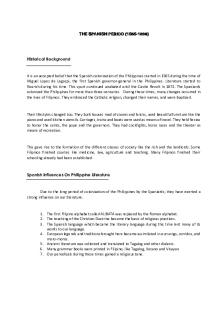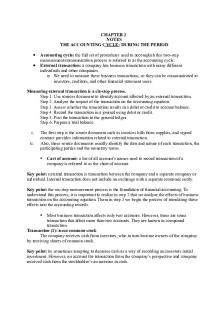BPM 40MCQ - here is the questions practice provided by the lecturer during 2016/17 PDF

| Title | BPM 40MCQ - here is the questions practice provided by the lecturer during 2016/17 |
|---|---|
| Course | Business Process Management |
| Institution | Deakin University |
| Pages | 7 |
| File Size | 95.8 KB |
| File Type | |
| Total Downloads | 96 |
| Total Views | 134 |
Summary
here is the questions practice provided by the lecturer during 2016/17...
Description
1. In Porter’s model, which of the following is not one of the five forces: a) Suppliers b) Customers c) Liquidators d) Substitute products and services e) Potential new entrants 2. Real time BPM can achieve all of the following except: a) Sense and respond to demand b) Provide self-service that delights, while cutting costs c) Automate the primary activities of the firm d) Execute on innovation with great speed and agility e) Ensure that every manual process in the organisation is automated 3. Which of the following is not classified as a generic activity undertaken by a process manager: a) Planning work b) Formulating strategy c) Organizing work d) Communicating e) Controlling 4. Which of the following is not an example of globalisation: a) Increased competition b) Outsourcing manufacturing to other countries c) Moving distribution to other countries d) Partnering with national suppliers 5. The point at which ownership of material being shipped passes from one company to another is known as: a) Delivery on board b) Free on board c) Documents on board d) Imports on board e) Exports on board 6. The increased use of information and communication technology to create, deliver, and use information, including the Internet and computer based information systems is referred to as: a) The business process revolution b) The computer revolution c) The information revolution d) The industrial revolution e) The global revolution
7. Staff who perform routine, structured activities, typically in a repeated manner are called: a) Knowledge workers b) Task workers c) Information workers d) Project workers 8. Harmon suggests that an operational manager is responsible for five things. Which of the following does not fit within this list: a) Identifying goals b) Organising activities c) Communicating goals to employees d) Diagnosing problems and fixing them e) Ensuring employee work/life balance 9. In BPM, Harmon consistently refers to and recommends a __________ view of management: a) Silo b) Process c) Functional d) Hierarchical e) Transparent 10. In the BPM discipline a ___________ __________ details how a company will create value for its customers. It defines the processes of the organisation. a) Business architecture b) Business process c) Change program d) Business plan 11. Which of the following issues is not typically considered under the industry based view of strategy: a) Cost reduction b) Retention of customers and suppliers c) Economies of scale d) Product differentiation e) Administering Level 8 processes 12. Cost leadership, differentiation and niche specialisation are all examples of: a) Project strategy b) Competitive strategy c) Internal strategy d) Process strategy e) Supply chain strategy
13. Product differentiation to gain strategic advantage means: a) Diversity b) Difference between revenues and expenses c) Commoditisation d) Uniqueness e) Market research 14. A large scale process in which every activity or sequence adds some value to the final product is called a: a) Strategy chain b) Process chain c) Business chain d) Value chain e) Activity chain 15. The term given to someone who has a vested interest in the process that we are trying to change is known as a: a) Manager b) Chief Executive Officer c) Stakeholder d) Process engineer e) Project manager 16. ________ ________ include outbound logistics, inbound logistics, marketing, and sales and service: a) Primary processes b) Support processes c) Competitive processes d) Business processes e) Process architecture 17. Another name for support processes is: a) Management processes b) Strategic processes c) Enabling processes d) Core processes e) Primary processes 18. Product leadership, customer intimacy and operational excellence are all examples of: a) External strategies b) Process strategies c) Positioning strategies d) Re-engineering strategies e) Project strategies
19. In the BPTrends process methodology, the value chain is normally designated as: a) Level 5 b) Level 0 c) Level 4 d) Level 2 e) Level 1 20. BPM is about: a) Aligning business processes to organisational strategy b) Maintaining a process view of the organisation rather than a functional view c) Establishing and maintaining an environment of continuous learning and development d) Communicating effectively e) All of the above
1. How many stages are there in the BPTrends business process redesign methodology? a) Five b) Four c) Three d) Two e) Seven 2. Data which are typically general in nature, such as who did what, when and where is referred to as: a) Organizational data b) Transactional data c) Master data d) Process data e) Enterprise data 3. Using the Balanced Scorecard approach for measurement, quarterly sales growth would be classified as: a) An internal measure b) A customer measure c) An innovation and learning measure
d) A financial measure 4. When managers view their organisations in a vertical manner, they tend to focus on the efficiency of their own departments without due regard to what is happening in other departments. This is known as: a) Strategic thinking b) Silo thinking c) Process thinking d) Competitive thinking e) Managerial complacency thinking 5. A ‘To Be’ redesign process, in conjunction with development and implementation plans approved and initiated, fits within which of the following redesign methodology stages: a) Phase 1 b) Phase 2 c) Phase 3 d) Phase 4 e) Phase 5 6. Which of the following is not included in the BPTrends redesign methodology? a) Roll-out change initiative b) Define as-is process c) Formulate strategy d) Innovate and consider could-be options e) Conduct process testing 7. Which of the following is not an intangible resource: a) Knowledge b) Skill c) Machinery d) Ability e) Maintenance of stakeholder relationships 8. A _______ _______ is a diagram that defines the relationships between ideas that knowledge workers rely on: a) Process map b) Concept map c) Strategic map d) Supply chain map 9. The procurement of supplies is generally considered to be an example of a: a) Strategic process b) Core process c) Management process
d) Support process 10._______ is a process framework that can be used to quickly define a supply chain architecture complete with benchmarked measures: a) SCAR b) SCOR c) SCIR d) SCTT e) SABRE 11. Evaluating vendors and negotiating contracts with them is an example of a: a) Management process b) Support process c) Core process d) Terminal elimination process 12. SCOR, VRM, DCOR and eTOM are all examples of: a) Business costing models b) Business process frameworks c) Business re-engineering philosophies d) Business strategy modeling diagrams e) Human resource measurement tools 13. Which of the following is not a factor in the human performance model: a) Activity standards b) Remuneration standards c) Consequences d) Feedback e) Skill, knowledge and capability 14. The _______ _______ is the difference between how we do things now and how we will need to do things in the future. a) Performance gap b) Capabilities gap c) Competency gap d) Knowledge gap e) Process gap 15. A document that provides verification that the specified goods have been received is called a: a) Verification document b) Critical receipt document c) Verification receipt document d) Goods receipt document e) Purchasing receipt document
16._______ include customers, suppliers, employees and anybody managing a process that interacts with the process you are going to try to change. a) Shareholders b) Managers c) Stakeholders d) Executives e) The Board of Directors 17. Something that defines or constrains how a business process is performed is typically called a/an: a) Constraint b) Problem c) Control d) Issue e) Definition 18. In the project scoping diagram, which is the odd one out: a) Controls b) Enablers c) Features d) Outputs e) Inputs 19. Which of the following is not a step in defining a preliminary business case: a) Define the As-Is process b) Determine what the As-Is process is or isn’t doing now c) Define what the To-Be process should do d) Consider how you will bridge the capabilities gap e) Ensure that every stakeholder has formally signed off the process scope 20. In BPM, DGSB stands for: a) Digital Group Standards Board b) Deakin Graduate School of Business c) Data Gradings Statutory Board d) Digital Grading for Systematic Barcoding...
Similar Free PDFs

Act 4 - Here is the package.
- 6 Pages

Services Provided by DNS
- 4 Pages

Practice Questions for the Midterm
- 109 Pages

The Philippines During Martial Law
- 12 Pages

Philit during the spanish period
- 6 Pages
Popular Institutions
- Tinajero National High School - Annex
- Politeknik Caltex Riau
- Yokohama City University
- SGT University
- University of Al-Qadisiyah
- Divine Word College of Vigan
- Techniek College Rotterdam
- Universidade de Santiago
- Universiti Teknologi MARA Cawangan Johor Kampus Pasir Gudang
- Poltekkes Kemenkes Yogyakarta
- Baguio City National High School
- Colegio san marcos
- preparatoria uno
- Centro de Bachillerato Tecnológico Industrial y de Servicios No. 107
- Dalian Maritime University
- Quang Trung Secondary School
- Colegio Tecnológico en Informática
- Corporación Regional de Educación Superior
- Grupo CEDVA
- Dar Al Uloom University
- Centro de Estudios Preuniversitarios de la Universidad Nacional de Ingeniería
- 上智大学
- Aakash International School, Nuna Majara
- San Felipe Neri Catholic School
- Kang Chiao International School - New Taipei City
- Misamis Occidental National High School
- Institución Educativa Escuela Normal Juan Ladrilleros
- Kolehiyo ng Pantukan
- Batanes State College
- Instituto Continental
- Sekolah Menengah Kejuruan Kesehatan Kaltara (Tarakan)
- Colegio de La Inmaculada Concepcion - Cebu










